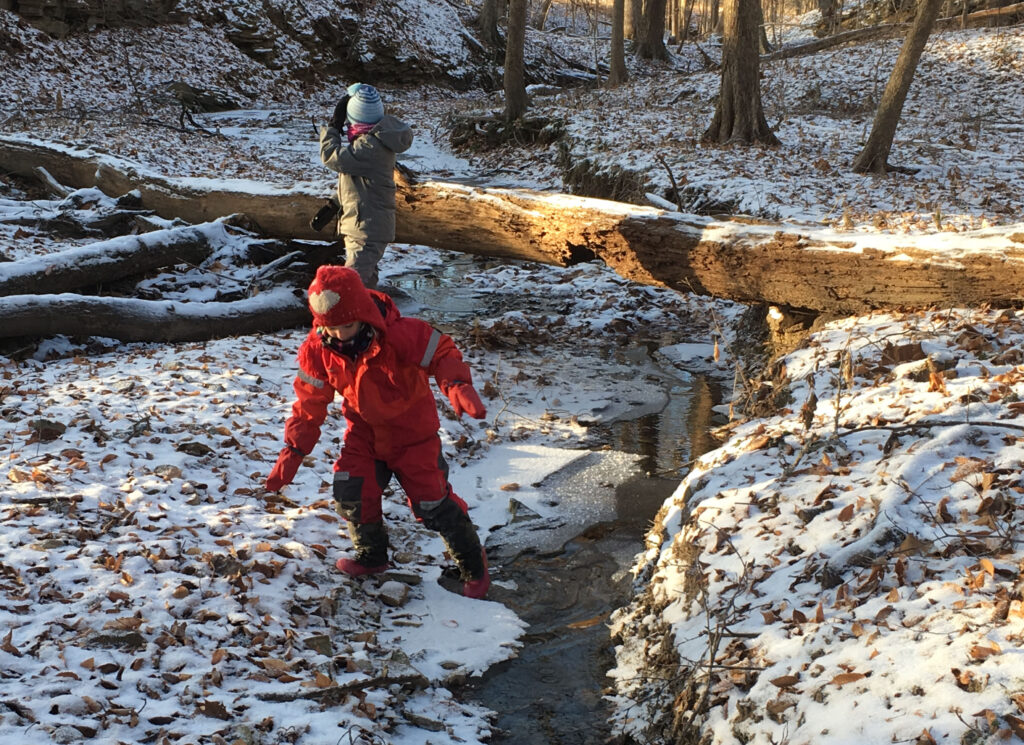By Kristin Palen, OTR/L
The plans are made, it’s a beautiful day and everything is ready. But there is one problem, your child doesn’t want to go outside! Maybe it’s the clothing layers, the gloves, the wind, the rain, the cold, or the heat holding them back. Neither you nor they may know the barrier, but it’s evident something is impeding their participation outside. It can be so frustrating as a parent, especially when you know how much your child enjoys being outdoors.
Sensory Processing Differences That May Impact Participation In Outdoor Activities
From feeling the warm sun on your face; to the cool breeze across your body; hearing the soft “tweet” of a bird, or feeling the earth between your finger’s, nature provides a full body sensory experience.
Sensory processing is your ability to take in sensory information from the environment, organize, interpret and then carry out a response (Miller et al., 2021). We all process sensory information differently and may be over responsive (over sensitive) or under responsive (under sensitive) to sensory input. Many of us are able to adjust our response to sensory input; but sometimes sensory differences may impede one’s participation in their everyday activities.

There are many sensory differences negatively impacted by the weather which may be contributing to your child’s hesitancy to go outside. Here are a few you may observe:
Interoceptive Awareness is your sense of internal body functions (temperature, thirst, heart rate, respiratory rate, hunger, etc.) that provide information of how your body feels inside (Miller et al, 2021). Some children may have an over responsivity to interoceptive awareness related to temperature which may cause colder and hotter outdoor temperatures to cause discomfort. On the contrary, if they have an under responsivity to temperature, they may not be as aware of the outdoor temperatures.
Tactile (touch) sensitivity is an over responsivity (over sensitivity) to tactile input. A child with tactile sensitivity may have difficulty wearing different clothing due to the texture, or the feeling of the fabric against their body; this may prevent them from wearing the appropriate clothing outside. Additionally, the feeling of the wind, rain or snow, touching things outside, and/or stepping on various surfaces can be aversive.
Sensory Based Motor Differences are related to postural control and a child’s ability to recognize where their body is in space (proprioceptive awareness) and how to move their body in space (vestibular awareness); as well as how to plan their motor actions. Children challenged in this area tend to display less control of their body, thus extra layers of clothing inhibiting their mobility may contribute to limited participation in outdoor activities.
Auditory sensitivity is an over responsivity to auditory information. A child with an over responsiveness to auditory input may be anxious to head outside if the wind is howling, if the trees are crackling or if they step on various landscapes when walking outside.
Visual sensitivity is an over responsivity to visual sensory information. A child with an over responsiveness to visual input may avoid being out in the bright sun, and the sun glaring over fresh snow may be especially aversive.
All of these factors may be contributing to your child’s avoidance of getting outside, to their discomfort of being outside and overall participation in outdoor activities.
Investigating Your Child’s Sensory Differences Related to Weather
Now that you have an understanding of sensory differences impacted by weather, it is time to investigate. Observe your child, think about the underlying factors limiting their participation outside. Take pictures of them in their outdoor clothing and outside in various weather conditions. When your child is regulated discuss the pictures. Ask them guiding questions about the clothing, the temperature, the weather factors (wind, rain, snow, cold, hot, etc.). From there you can identify the sensory differences and possible weather challenges contributing to your child’s reactions.

Time to Take Action: 7 Steps to Supporting Your Child With Sensory Differences to Enjoy All Weather
- Teach your child about the weather: Read books about the weather, tell stories, observe the weather, discuss the clothing, and do weather experiments. This will help your child understand the weather and how it relates to their sensory experiences.
- Teach your child to attune to their body signals: Teach your child to do body checks by identifying how each body part feels outside. For example, “Do my arms feel stiff or relaxed?”, “How does my skin feel?”, “How does my face feel against the wind?”, etc. for your child to identify natures impact on their sensory systems.
- Establish regulating sensory strategies: Identify what activities are most regulating for your child, such as getting a big bear hug, dancing, climbing trees, riding bikes, etc. Whatever it is, set them up for success by participating in regulating activities prior to heading outside, when outside and as needed if they become distressed outside.
- Develop accommodations and adaptations: Experiment with different clothing layers, hats, sunglasses, jackets, places outside to play, etc. to find works best. Provide them with visual supports such as pictures of clothing, where you will go, and a plan if you become disrupted weather.
- Establish boundaries and self-advocacy: Encourage your child to advocate for themselves by expressing their feelings and establish boundaries when going outside. Such as a certain wind strength to be comfortable in, the heaviness of the rain, or establish what temperature you can safely play in outside, etc. This gives your child more autonomy over an unpredictable situation like the weather.
- Practice and Role Play: Once you come up with a plan of your accommodations, adaptations, boundaries and clothing, practice with your child! You can try this with puppet shows, roll playing, drawing pictures, and/or telling stories of the preparations needed to go outside and what you will do once outside.
- Practice positive mindset: Having a positive mindset is of the utmost importance when enjoying the outdoors in all weather. Model, demonstrate and practice with your child. Make a list of the things you can do in all different kinds of weather, then you have a plan of what you can do no matter the weather outside.
Don’t let sensory differences get in the way! It might take a little more practice and preparation but by following the above steps you will have your child outside exploring nature in all weather! If your child continues to struggle in this area, an evaluation with an occupational therapist may be beneficial to assess your child’s sensory processing skills.
Reference: Miller, L. H., Porter, L. M., & Bialer, D. S. (2021). No Longer a Secret: Second Edition. Sensory World.

About Kristin:
Kristin Palen, OTR/L is an occupational therapist with over 19 years of experience solely in pediatrics. Kristin is the owner of Coastal Connections Pediatric Therapy, in the Outer Banks North Carolina. Her practice provides direct nature based occupational therapy services, virtual parent coaching and masterclasses coming soon. In addition to being an OT Kristin is also a homeschool mom. Being part of a neurodiverse family Kristin particularly enjoys supporting and coaching fellow neurodiverse homeschool families to adapt, accommodate and meet the needs of their unique children. Find out more about Kristin’s practice here and follow her on Instagram.


Excellent post! I wish I had known this when my son was little, but I’m thankful that we did so many of these things. Now his son has some of the same sensory differences. Thanks for sharing!
Thanks, I’m glad you enjoyed it! I think it’s always valuable to hear some insights from somebody who works with these issues on a daily basis.